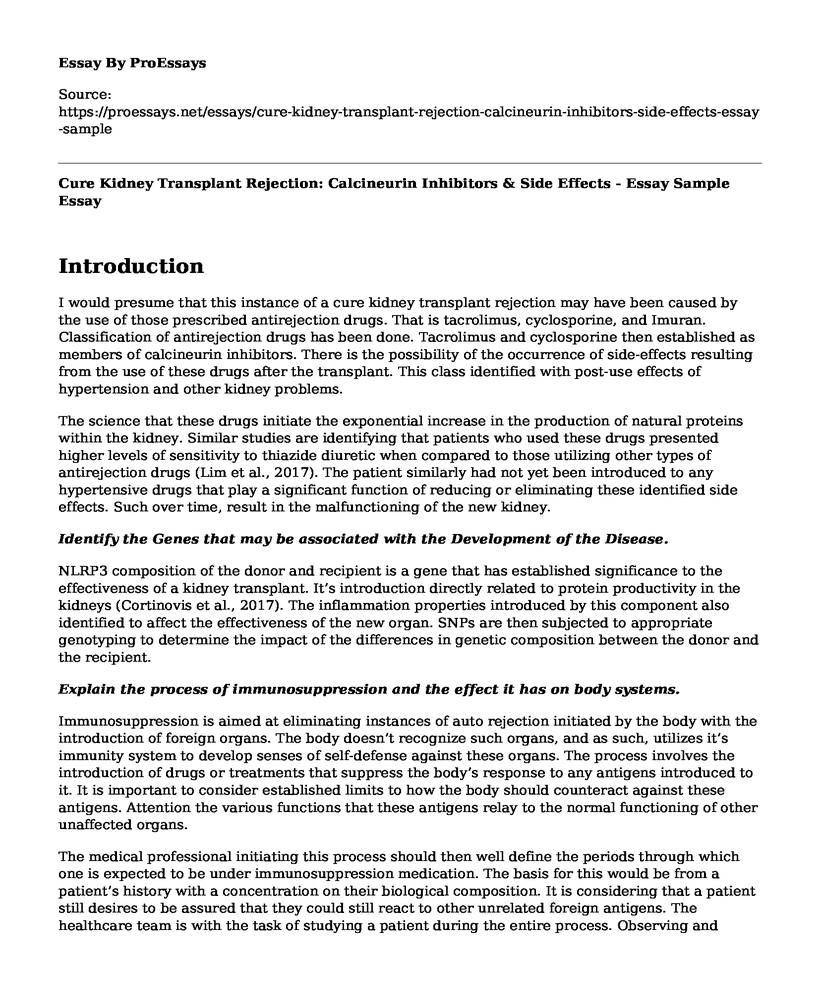Introduction
I would presume that this instance of a cure kidney transplant rejection may have been caused by the use of those prescribed antirejection drugs. That is tacrolimus, cyclosporine, and Imuran. Classification of antirejection drugs has been done. Tacrolimus and cyclosporine then established as members of calcineurin inhibitors. There is the possibility of the occurrence of side-effects resulting from the use of these drugs after the transplant. This class identified with post-use effects of hypertension and other kidney problems.
The science that these drugs initiate the exponential increase in the production of natural proteins within the kidney. Similar studies are identifying that patients who used these drugs presented higher levels of sensitivity to thiazide diuretic when compared to those utilizing other types of antirejection drugs (Lim et al., 2017). The patient similarly had not yet been introduced to any hypertensive drugs that play a significant function of reducing or eliminating these identified side effects. Such over time, result in the malfunctioning of the new kidney.
Identify the Genes that may be associated with the Development of the Disease.NLRP3 composition of the donor and recipient is a gene that has established significance to the effectiveness of a kidney transplant. It’s introduction directly related to protein productivity in the kidneys (Cortinovis et al., 2017). The inflammation properties introduced by this component also identified to affect the effectiveness of the new organ. SNPs are then subjected to appropriate genotyping to determine the impact of the differences in genetic composition between the donor and the recipient.
Explain the process of immunosuppression and the effect it has on body systems.
Immunosuppression is aimed at eliminating instances of auto rejection initiated by the body with the introduction of foreign organs. The body doesn’t recognize such organs, and as such, utilizes it’s immunity system to develop senses of self-defense against these organs. The process involves the introduction of drugs or treatments that suppress the body’s response to any antigens introduced to it. It is important to consider established limits to how the body should counteract against these antigens. Attention the various functions that these antigens relay to the normal functioning of other unaffected organs.
The medical professional initiating this process should then well define the periods through which one is expected to be under immunosuppression medication. The basis for this would be from a patient’s history with a concentration on their biological composition. It is considering that a patient still desires to be assured that they could still react to other unrelated foreign antigens. The healthcare team is with the task of studying a patient during the entire process. Observing and analyzing their reaction to the type of medication they were introduced to (Grinyo & Bestard, 2017). It is by consequently performing related changes to the type and dosage of the drugs previously selected for use. The primary purpose of this is to identify and implement treatment procedures that significantly reduce the risk of organ rejection.
The major effect of immunosuppression on the body system is the destruction of most of the vital sections of the immune system. Such increases a patient’s vulnerability to other infections. Other foreign cells introduced onto the body can then reside without counter-reaction by the body’s immune system. Normal body system functions consequently altered.
References
Cortinovis, M., Remuzzi, G., Perico, N. (2017). Maintenance immunosuppression in kidney transplantation. Kidney Transplantation, Bioengineering, and Regeneration, 259-276. https://doi.org/10.1016/B978-0-12-801734-0.00020-5.
Grinyo, J.M., Bestard, O. (2017). Induction immunosuppression in kidney transplantation. Kidney Transplantation, Bioengineering, and Regeneration, 247-258. https://doi.org/10.1016/B978-0-12-801734-0.00019-9
Lim, M.A., Kohli, J., Bloom, R.D. (2017). Immunosuppression for kidney transplantation: Where are we now and where are we going? Transplantation Reviews, 31(1), 10-17. https://doi.org/10.1016/j.trre.2016.10.006
Cite this page
Cure Kidney Transplant Rejection: Calcineurin Inhibitors & Side Effects - Essay Sample. (2023, Aug 28). Retrieved from https://proessays.net/essays/cure-kidney-transplant-rejection-calcineurin-inhibitors-side-effects-essay-sample
If you are the original author of this essay and no longer wish to have it published on the ProEssays website, please click below to request its removal:
- Basing Nursing Practice on Evidence
- Essay Sample on Transforming Global Health
- Essay on Staff Burnout & Compassion Fatigue: Study at Heartland Behavioral Healthcare
- Essay Sample on Hospitals: Improving Community Health Through Community Benefit Activities
- Paper Example on Nurse Practitioners: A Growing Need for Quality Healthcare
- A Life Worth Ending: Essay Sample on Autonomy and Mortality
- Protect Yourself and Loved Ones with Influenza Vaccination - Essay Sample







